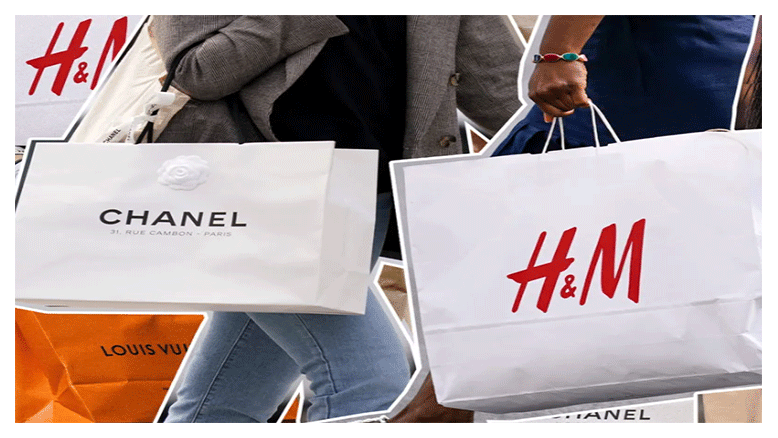Will luxury fashion survive the rise of the mass market and commercial goods in the years ahead? And more importantly, what truly distinguishes luxury from the mainstream today?
Let’s begin by unpacking an example from the 2021 Met Gala in New York.
When Luxury Fashion Looks Like Mass Market
At the event, Kim Kardashian West arrived in a full-body black gown designed by Demna Gvasalia, inspired by Kanye West. The look, which covered her entire body and face, loudly deviated from the evening’s theme, “In America: A Lexicon of Fashion.”
While media outlets spun narratives to justify the outfit’s symbolism—arguing it referenced anonymity or America’s shifting identity—what it truly compromised was Balenciaga’s brand integrity. The design resembled something from Shein, the hallmark of a rising Asian mass market brand, rather than the legacy of Cristóbal Balenciaga, identifiable by his dedication to concept-driven collections, masterful style & tailoring, and meticulous quality.
This moment reflects a broader shift: luxury fashion is beginning to resemble the very mass market it once stood apart from—both in design and philosophy.
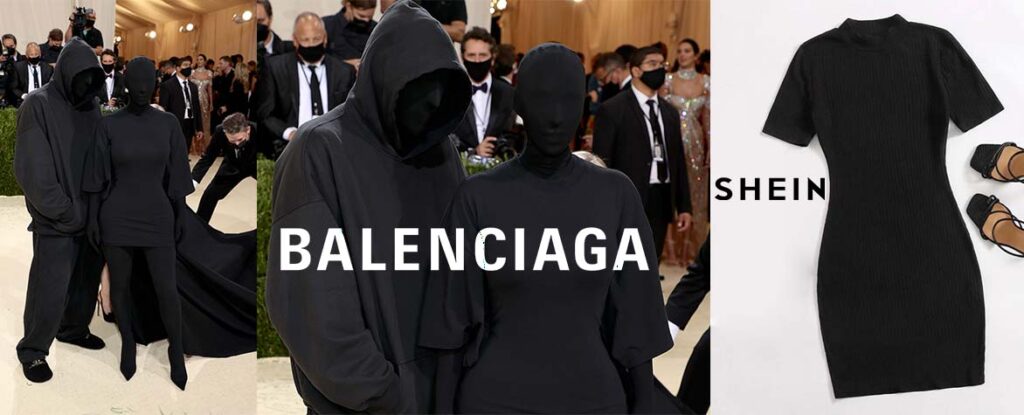
What Is Luxury Fashion Now?
Luxury fashion today is often reduced to mass-produced goods bearing the names of long-dead masters, justified only by media hype and manufactured scarcity. Gone is the dedication to quality, exclusivity, and sustainability, once the very pillars of luxury. Now, “luxury” seems to be an inflated price tag without the craftsmanship to match.
Let’s explore this further with a direct product comparison that pits luxury fashion against a respected mass market alternative.
A Case Study: Gucci vs Furla, Luxury Fashion and the Mass Market
Being a Fashionista and a Marketing enthusiast, I believe it’s essential to evaluate quality through the lens of craftsmanship, not just branding. While Gucci represents luxury fashion and Furla falls into the premium mass market category, the gap in price doesn’t always reflect a proportional difference in product quality.
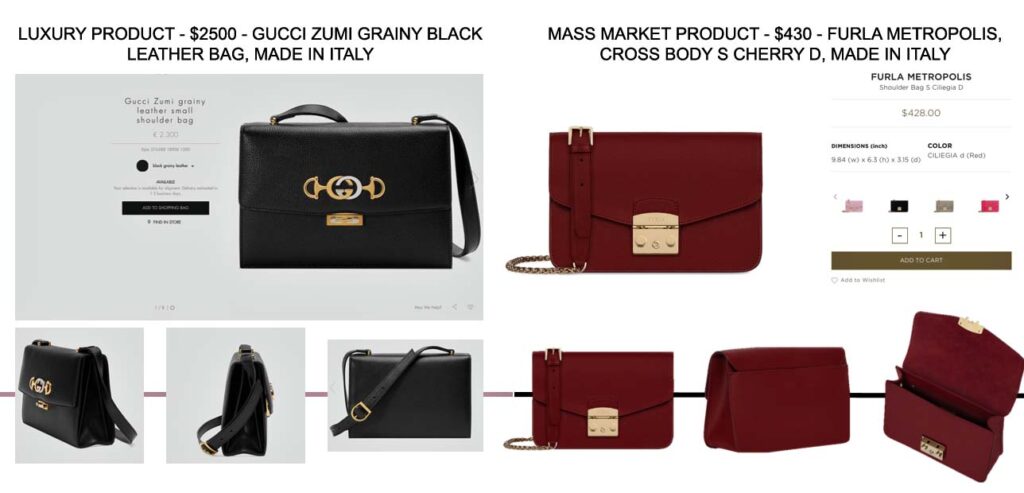
Leather Quality
The Gucci bag is made from vegetable-tanned, grainy calfskin—soft, durable, and resistant to cracking or drying out, ensuring longevity. Furla, on the other hand, uses what it labels as “Saffiano leather,” famously associated with Prada. But in this case, the bag incorporates split leather with a coated crosshatch print—mimicking the real thing. Despite this, Furla’s leather still performs well, offering water resistance and decent structure.
Stitching Techniques
Gucci applies deep-set, tone-on-tone stitches on the exterior and elevated stitches inside—an indicator of sturdy leather and thoughtful construction. Furla uses straight tone-on-tone stitching, commonly applied to soft leathers. The difference shows that Gucci’s techniques result in a sturdier and more polished build, typical of luxury fashion.

Hardware and Zippers
Both brands use gold-tone hardware, but Gucci’s iconic mix of polished gold and silver GG clamps is drawn from its archives, while Furla relies on simpler gold-plated brass. Zippers reveal a stark contrast: Gucci uses metal zippers with a smooth polish; Furla employs plastic coil zippers, which are prone to breaking if overused.
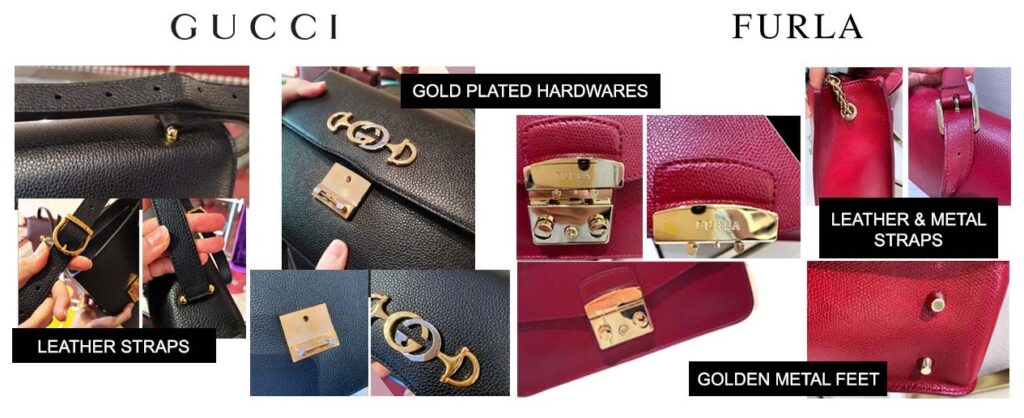
Gucci lines its bag with patterned satin fabric, while Furla uses microsuede with unfinished stitches. Neither brand properly finishes the bag’s borders—a surprising lapse for both luxury fashion and mass market segments.
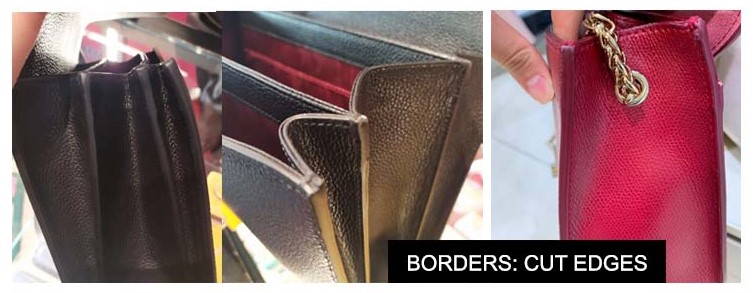
Quality Check: Luxury Fashion and Mass-Market
To summarise, the quality of Gucci leather is superior to and durable than that of Furla. Both bags, however, did not have well-finished borders, which is the defining feature of their appearance, signifying a prominent detail that defines craftsmanship. A notable difference between the two products is that Gucci might survive for a lifetime, whereas Furla will last five years or more, depending on its maintenance. However, leather quality alone can no longer justify the stark price difference.
Design, Aesthetics, and Functionality of both bags are strikingly similar. This raises a crucial question: where exactly is the line that separates luxury fashion from the mass market?
Many luxury products today share craftsmanship levels nearly indistinguishable from mid-range or even fast-fashion items. If luxury is meant to represent emotional labour, artisanal care, and timeless design, then why do they feel like overpriced echoes of mass-produced goods?
What’s worse, mass-market brands routinely copy luxury designs at high speed, bypassing copyright and blurring originality. But even luxury brands now mimic mass-market tactics: creating relentless seasonal drops, overworking designers, and sacrificing quality for quantity. This results in watered-down collections devoid of soul or innovation.
When luxury starts acting like the mass market, producing at its pace and standard, the distinction fades. If the soul of fashion lies in its design and intention, then both are being eroded by a system that values trend turnover over true craftsmanship.
So really—is the $2500 Gucci bag worth it, or just another well-marketed product in the fast lane of fashion’s commercial chaos?
Why Is Forgery Taboo in Old Masters Art but accepted in Fashion Heritage and Sustainability?
You wouldn’t proudly hang a forged Picasso in your living room. So why is it acceptable for fashion conglomerates to mass-produce rebranded versions of iconic heritage designs—and sell them at luxury prices?
Fashion houses once built their legacies on distinctive styles and philosophies. Gucci had its equestrian elegance, Balenciaga its architectural minimalism. These identities were unique and recognisable. But under corporate giants like Kering and LVMH, brand identities are being flattened in the name of inclusivity and trend alignment.
These conglomerates now rebrand the aesthetics of long-deceased designers—whose names still headline the collections—while offering products that barely reflect the original vision. This isn’t homage; it’s commercial forgery. Yet it’s celebrated, sold, and consumed as luxury.
In the art world, selling a forged Picasso would be a scandal. But in fashion, PR & Marketing agencies spin it into a narrative of sustainability or nostalgia. This manipulation shapes a culture that’s emotionally charged yet creatively hollow, eroding fashion heritage under the weight of performance-driven branding.
Corporate actions have destroyed the fashion heritage and the environment. However, luxury business status had drastically declined even before the pandemic, and the Coronavirus worsened things, causing a 90 per cent profit decline for the entire luxury fashion industry.
The end result? A homogenised market where Gucci, Dior, Balenciaga, and other Fashion heritage lose their once-distinct language. Today, luxury is measured not by integrity or innovation, but by how well it mimics virality.
What Does the Future Hold for Luxury Fashion and the Mass Market?
Is luxury fashion just glorified theft now? Or are we just entering a new commercial age where the line between luxury fashion and mass market is indistinguishable?
Typically, luxury products are bought by the wealthy, but their high price tags have never been the driving force of luxury fashion. Many highly talented fashion designers, such as Thierry Mugler, Alexander McQueen, and Guccio Gucci, came from humble beginnings. Their talent and drive for art led them to give what the fashion industry demanded. Today, brands strive to promote brand inclusion, but this does not necessarily mean they have to lose their identity.
Fashion, at its best, is a medium of emotion, storytelling, and identity. For luxury fashion to be meaningful again, it must reconnect with its roots—because fashion shapes identities, not just a consumer profile.
A Call for Conscious Creativity in Fashion
There is still hope. Around the world, emerging designers are committing to authentic craftsmanship, sustainable practices, and emotional resonance. Instead of endlessly funding massive corporations clinging to dead masters’ names, maybe it’s time we support those building something new—something that honours the balance between creativity and capital.
Let’s champion fashion that values people, planet, and purpose—whether it’s luxury fashion or a redefined mass market rooted in integrity.

